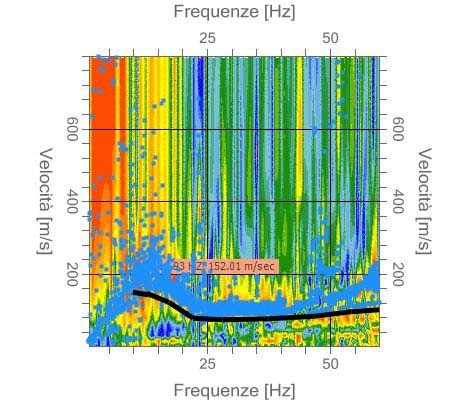It is possible to interpret a REMI test with Easy Masw by using a picking maneuver: instead of doing it on the maximums (dark-colored areas), we do it on the minimums, or the part where the light-colored shade starts.

As shown in the picture, it would be required to perform the picking immediately below the point cloud which determines the maximums’ section. The stringing used to derive the spectrum in the above picture is probably short, so the same figures of a masw are valued.
In the REMI test the stringing length is important – good results are obtained with lengths higher than 80m.
To understand the behavior of the two techniques, it is enough to string out 24 geophones spaced by at least 2 or 2.5 meters in an area of sharp signal, such as a clay formation thicker than 50 or 60 meters.
The steps are the following:
•we perform the MASW and REMI registration on the same stringing;
•we do the MASW picking;
•we overlap the REMI picking.
We can see in the picture how the picking on REMI up to frequencies higher than 10Hz is positioned lower than the maximums.
The MASW provides a better resolution than the REMI up to approximately 15-20Hz, but the REMI should be more accurate up to approximately 5Hz.
A good precaution in a REMI test is to extend the signal to at least 2 seconds. The downside is that of not reaching high depths on particularly soft terrains.
However, the technical practice highlighted that a one-second-long signal is enough to investigate 90% of the cases. To stabilize the signal it would be opportune to have tracks longer than a minute, add up multiple files and perform the analysis.
|
© Geostru